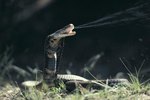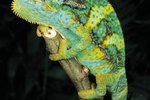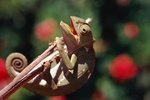
Some lizards have a flap of skin beneath their head and neck, termed a dewlap. The color, size and shape of the dewlap varies by species, gender, and to an extent, individual. Some species effect elaborate, choreographed routines to communicate with other lizards, much like birds or frogs use vocalizations to communicate with each other.
Anoles
Dewlaps are best known, and are perhaps most advanced in, the anoles (Polychrotidae). Made up of four closely related genera, most importantly Anolis, anoles are small, mostly arboreal lizards native to North America, Central America, South America and the Caribbean Islands. Anoles fill a variety of niches when different species live alongside each other, partitioning themselves by microhabitat. The lizards further distinguish themselves by the colors of their dewlap, and the pattern of display they use.
Dewlap Design
Females of most species have relatively small dewlaps that hang from their necks, and are usually the same general color as the rest of the animal. Males often have large, brightly colored dewlaps that they move via a set of bones in the neck, called the hyoid apparatus. This allows the dewlap to be concealed when the lizard is not displaying it, so he can remain hidden from predators.
Attracting Mates
One very important and well documented purpose of the dewlap is for attracting mates. Mature males will seek out a conspicuous perch in their territory and execute a choreographed set of head bobs, push-ups and dewlap movements. Receptive females will then make themselves visible or approach the male for breeding. Though not common, a 2012 study by Alexis Harrison and Steven Poe, published in the "Biological Journal of the Linnean Society," showed that females from some anole populations have dewlaps that may be used to signal males, a rare trait among the group.
Territoriality
Male anoles will maintain and patrol a territory, the size of which varies with individual and species. While females and juveniles are generally granted passage, males will attempt to exclude other males. Usually this is accomplished through head bobbing, dewlap displays and intimidation, but it can escalate further in some cases. Fighting can lead to injuries or even death, so it is generally rare; in most cases the smaller animal will back away. Some species have submissive gestures that subordinate males will display to halt the aggression of a larger male.
Defense
Though not typical behavior of anoles, green iguanas will extend their dewlap when defending themselves from predators. They start the display by turning sideways, lifting the head and then extending the dewlap to appear as large as possible. While giving the display, the lizard may also puff his body with air, hiss loudly or whip his tail at the perceived adversary. It is possible that the large subtympanic scale may appear to be an eye at the center of a very large lizard's head, a tactic used throughout the animal kingdom.
References
- Smithsonian National Zoological Park: Green Anole
- Loyola Center for Environmental Education: Anoles and Dewlaps
- Biological Journal of the Linnean Society: Evolution of an Ornament, the Dewlap, in Females of the Lizard Genus Anolis
- PLOS ONE: Evolution of Anolis Lizard Dewlap Diversity
- Animal Diversity Web: Polychrotidae
- Melissa Kaplan's Herp Care Collection: Green Iguana Dewlaps
Photo Credits
-
Thinkstock/Stockbyte/Getty Images



